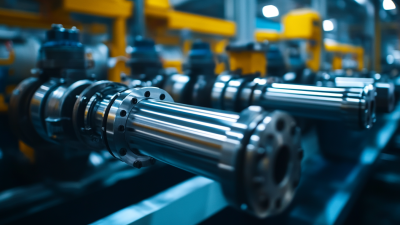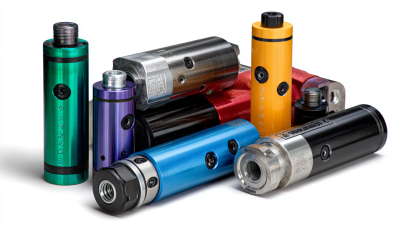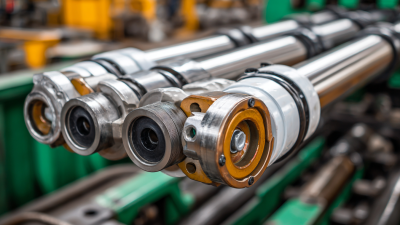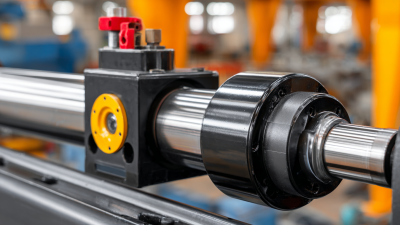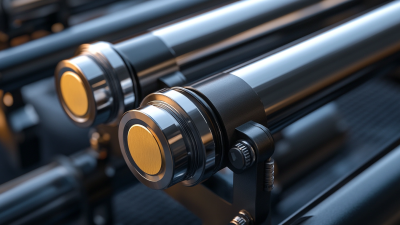Empowering Engineering Excellence: Innovate, Elevate, Deliver.
Hydraulic Cylinder Parts play a critical role in the performance and reliability of hydraulic systems, which are essential across various industries, including construction, manufacturing, and agriculture. According to a report by MarketsandMarkets, the global hydraulic cylinder market is projected to reach USD 18.5 billion by 2026, driven by the increasing demand for efficient and reliable machinery. Understanding the essential components of hydraulic cylinders, such as rods, seals, and pistons, is crucial for optimizing their functionality and longevity. Proper maintenance and selection of high-quality hydraulic cylinder parts can significantly reduce system downtime and maintenance costs, leading to improved operational efficiency. As the industry continues to evolve and innovate, mastering the intricacies of hydraulic cylinder parts will become increasingly vital for those seeking to enhance productivity and performance in their applications.

Hydraulic cylinders are critical components in many machinery systems, and understanding their key components is vital for ensuring optimal performance. At the heart of a hydraulic cylinder is the piston, which converts hydraulic energy into mechanical force. This movement is facilitated by the cylinder barrel, which houses the piston and maintains hydraulic fluid pressure. Identifying any signs of wear in these components can indicate a decline in performance, making regular inspections essential.
Another essential part is the seals, which prevent hydraulic fluid from leaking and maintain pressure within the system. High-quality seals can enhance the system's efficiency and durability. Additionally, the rod, which extends from the piston, plays a crucial role in transferring force to the load. It's important to choose materials for rods that can withstand corrosion and wear, especially in harsh working environments. Understanding these components not only helps in maintaining performance but also aids in troubleshooting potential issues.
Choosing the right materials for hydraulic cylinder parts is crucial for ensuring their durability and optimal performance. Various factors come into play when selecting these materials, including strength, corrosion resistance, and operating temperature range. For instance, materials such as high-strength carbon steel or stainless steel are often preferred for their excellent mechanical properties and resistance to wear. Additionally, specialized coatings or surface treatments can enhance longevity and protect against environmental factors.
Another important consideration is the compatibility of materials with the hydraulic fluids used in the system. Certain materials may react adversely with specific fluids, leading to premature failure or breakdown. Therefore, understanding the chemical properties of both the materials and the hydraulic fluids is essential. As the hydraulic cylinder market is projected to grow from $10.94 billion in 2018 to $19.77 billion by 2032, selecting the right materials will become increasingly important for manufacturers aiming to deliver reliable and robust hydraulic solutions.
This chart illustrates the strength of different materials commonly used for hydraulic cylinder parts. The choice of material can significantly impact the performance and durability of hydraulic systems.
Maintaining hydraulic cylinder components is crucial for ensuring their long-lasting efficiency and optimal performance. According to a report by the International Fluid Power Society, nearly 70% of hydraulic system failures are linked to inadequate maintenance. Regular inspection and maintenance not only extend the life cycle of hydraulic components but also significantly improve operational reliability. Operators should focus on monitoring fluid levels and quality, ensuring that the hydraulic fluid is free of contaminants to prevent wear on seals and other critical parts.
The implementation of a scheduled maintenance plan can drastically reduce downtime. Research indicates that facilities employing predictive maintenance strategies can see up to a 25% reduction in maintenance costs. This includes routine checks for signs of wear and tear, alignment issues, and ensuring proper lubrication. Utilizing advanced diagnostic tools and techniques, such as infrared thermography and vibration analysis, can further enhance the identification of potential issues before they lead to costly failures. By investing in inspections and adhering to maintenance protocols, companies can ensure their hydraulic systems operate at peak efficiency, reducing the likelihood of unexpected breakdowns and prolonging equipment lifespan.

Hydraulic cylinders are crucial components in various machinery, and troubleshooting issues is essential for maintaining optimal performance. Some common problems include leaks, unresponsive movement, and unusual noises during operation. Identifying the source of leakage can often be the first step in troubleshooting. Common areas to check include seals, fittings, and welds, as these are prone to wear and tear. Regular inspection of these components can help detect early signs of failure, allowing for timely intervention before major repairs are needed.
Another common issue is unresponsive movement, which can stem from low hydraulic fluid levels or air trapped in the system. Ensuring that the fluid is at the appropriate level and bleeding the system of trapped air can often restore functionality. Unusual noises, such as grinding or clanking sounds, may indicate internal damage to the cylinder or misplaced components. In such cases, a thorough inspection and possible disassembly may be required to address any mechanical issues effectively. By systematically addressing these common problems, operators can ensure that hydraulic cylinders remain efficient and reliable in their applications.
| Component | Function | Common Issues | Solutions |
|---|---|---|---|
| Piston | Converts hydraulic energy into linear motion. | Piston wear or damage. | Replace piston. |
| Cylinder Barrel | Houses the piston and contains hydraulic fluid. | Leaks or cracks in the barrel. | Inspect and replace if necessary. |
| Seals | Prevents fluid from leaking out of the cylinder. | Seal degradation or failure. | Replace seals. |
| Rod | Transmits force from the piston to the load. | Rod bending or surface damage. | Realign or replace rod. |
| End Caps | Holds the cylinder assembly together and contains seals. | Corrosion or damage. | Replace end caps. |
 When optimizing the design of hydraulic cylinder parts for enhanced functionality, it is crucial to consider various essential components such as seals, rods, and ports, which play a significant role in overall performance. Innovative CAD technologies can significantly aid in this design process, allowing engineers to create more efficient and reliable systems in a shorter time frame. By utilizing advanced modeling capabilities, designers can simulate real-world conditions, ensuring that every part is crafted for optimal operation.
When optimizing the design of hydraulic cylinder parts for enhanced functionality, it is crucial to consider various essential components such as seals, rods, and ports, which play a significant role in overall performance. Innovative CAD technologies can significantly aid in this design process, allowing engineers to create more efficient and reliable systems in a shorter time frame. By utilizing advanced modeling capabilities, designers can simulate real-world conditions, ensuring that every part is crafted for optimal operation.
Tips: Always prioritize selecting high-quality materials that meet the specific demands of your hydraulic systems. This not only prolongs the lifespan of the components but also enhances the performance of the entire cylinder. Additionally, incorporating feedback mechanisms within the design can provide valuable insights for continuous improvement.
Moreover, embracing recent advancements in CAD software can streamline communication among team members, resulting in a more cohesive design approach. Features such as thermodynamic simulations and fluid dynamics analyses can provide a deeper understanding of how various designs will perform under different conditions, enabling engineers to fine-tune designs before actual production.
